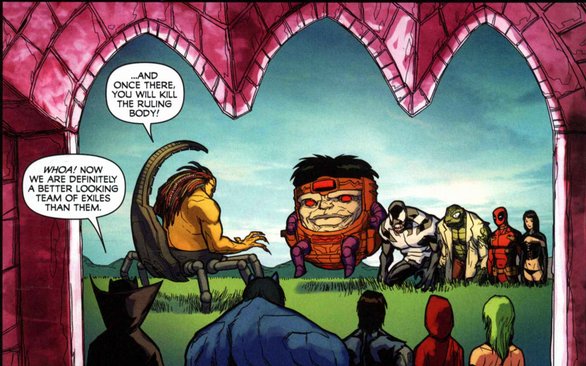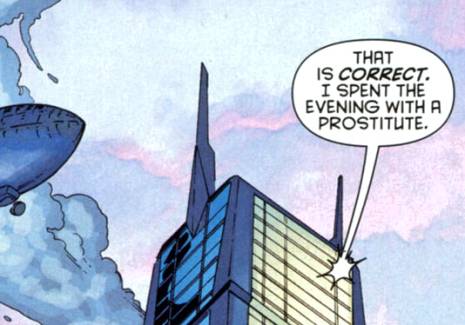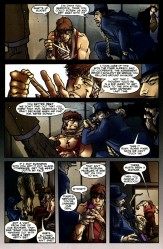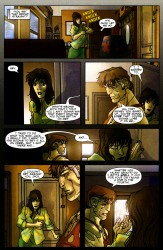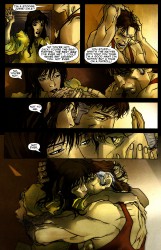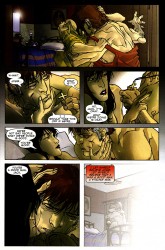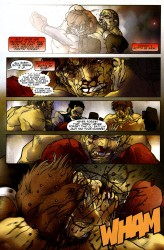A few days before I received my copy of Eiichiro Oda’s One Piece: East Blue 1-2-3, Shueisha announced that One Piece volume 56 had a print run of 2.85 million copies, the largest first edition print run in manga history. A couple days after I finished reading its 600 pages, a chart detailing the best-selling manga in Japan by series for 2009 dropped, revealing that One Piece sold 14,721,241 copies over the course of the year. To put this in perspective, according to Brian Hibbs’s Bookscan analysis for 2008, the total units for comics sold in America last year was 15,541,769. The top 750 sold 8,334,276 total copies.
What I’m trying to say is, even before you factor in toys, movies, other media tie-ins, and video games (though if you don’t own a Wii, it’s been a while since one of those), One Piece is an industry of its own. It’s kinda like a big deal.
It’s not hard to see why. One Piece is the story of Monkey D. Luffy, a teenager who wants to be the King of the Pirates by finding Gold Roger’s lost treasure “One Piece.” Along the way, he collects a crew of interesting weird crewmates, battles incredible enemies, leaves a trail of broken bodies and new friends in his wake, and punches so far above his weight class it’s a wonder that he doesn’t simply get squashed by his betters.
Except this is shonen manga, and like every other shonen hero, Luffy has heart, magic powers, the power of true friendship, and about thirty gallons of blood in his body. His heart comes from his drive to become King of the Pirates and live up to the expectations of his mentor, Red-haired Shanks. His friendship comes from the mutual respect between all members of the crew, even when they quarrel. The blood is a genre trope, and the magic powers come from the time he eat the Gum Gum Fruit, which turned him into a rubber man.
Luffy is kind of like Reed Richards, if Reed was good at fighting, really really dumb, but focused enough to achieve anything he put his mind to. His rubber skills range from purely offensive (Gum Gum Gatling) to protective (Gum Gum Balloon) to ridiculous (Second Gear), but they are all visually entertaining.
Oda’s style is somewhere between Dragon Ball and Looney Tunes. The proportions vary from character to character (Nami’s impossibly long stick legs [she’s like 2/3 legs, seriously], Usopp’s nose having actual bones in it, Luffy’s rubber body, Buggy’s weird face), but they all manage to look good. It looks weird, but endearingly so. Several traits that I usually associate with American animation or cartooning mix with traditionally Japanese effects, resulting in situations where characters simultaneously bug their eyes out like Ren & Stimpy while sweat drops or anger clouds (for lack of a better phrase, the swirly anger stuff usually seen around yakuza/hooligans) flood the panel.
One Piece has some great fight scenes, in part due to the weirdness of the design and art. Characters have powers that are more than just “shoots lasers” or “ninjutsu.” One guy splits apart into floating pieces, another’s made out of sand, another uses three swords at a time (Santoryu: Three Sword Style means two in the hand, one in the mouth), and still another just has an ill iron jaw and an axe for a hand.
East Blue: 1-2-3 collects the first three volumes of the series for fifteen bucks or so and establishes everything that you need to know. The piracy tends toward the fun and melodramatic, but there’s a clear delineation between fun and “We will straight up kill you.” Luffy and friends stay on the fun side, of course, but some of their villains are genuinely villainous.
Over the course of the volume, we meet the first three members of Luffy’s crew, though the third doesn’t join just yet, get all of the introductory business out of the way, and meet a gang of villains, only a couple of which are recurring characters. You get to know the weird nature of the series through the lion tamer who has hair just like his pet Richie (it’s not a mask) and Luffy’s Amelia Bedelia-esque nature.
He’s very… credulous, if I can use that word like that. He’s not too far off from Yotsuba in that sense. When an enemy, when referring to one of Luffy’s friends, says, “Maybe I know… then again, maybe I don’t,” Luffy simply responds, “What are you talking about? Are you an idiot?”
Oda created a manga that’s both funny looking and funny. It switches from hardcore action to comedy to tear-filled drama at a moment’s notice, and it never feels like a jerk from one kind of writing to another. It’s always very smooth and well-earned.
One Piece is one of my favorite manga, and it’s definitely the one I’ve stuck with the longest and read the most of. I discovered it back when Shonen Jump first started, and though I’ve taken breaks off and on, it’s one I’ve kept up with over the years.
Oda’s painted a world that’s a great storytelling engine, with enough freedom to tell almost any kind of story. Just when you think you’re going to get yet another story about pirates vs pirates, you end up with a civil war or a trip to heaven or something equally ridiculous. (Both of those happened.) Or hey, you can get a madcap escape from an underwater jail with several floors of gimmicks. It’s fresh and interesting and it’s easy to see why it’s such a huge hit in Japan. It’s childlike in a way that adults and kids can both appreciate, not very deep, but immensely entertaining.
I’ve got to praise this new 3in1 format, too. It’s a masterstroke, making it easy for new readers to get into the series or long-time readers to have handsome new volumes on their shelves. If you get impatient, you can just pick up the series where the omnibus leaves off. East Blue covers the first twelve trades, so there are three more of these due over the next few months. I’m hoping that these sell well enough to justify the next arc, and the arc after that, catching 3in1 releases. I love these. I went ahead and preordered the next three (4-5-6 , 7-8-9
, 7-8-9 , and 10-11-12
, and 10-11-12 ), because, at Amazon prices, these are basically three for the price of one at full retail.
), because, at Amazon prices, these are basically three for the price of one at full retail.
That’s a steal.

